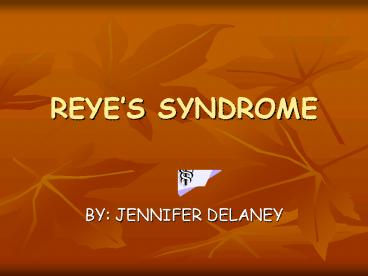REYES SYNDROME - PowerPoint PPT Presentation
1 / 23
Title:
REYES SYNDROME
Description:
HISTORY CONT. ... IV fluids- glucose & electrolyte solution with sodium, potassium, and chloride. ... The Western Journal of Medicine, Reye's Syndrome. Taber's ... – PowerPoint PPT presentation
Number of Views:2022
Avg rating:3.0/5.0
Title: REYES SYNDROME
1
REYES SYNDROME
- BY JENNIFER DELANEY
2
OBJECTIVES
- HISTORY
- ETIOLOGY
- WHAT IT DOES
- SIGN SYMPTOMS
- STAGES
- WHAT WE WILL BE CALLED FOR
- DIAGNOSIS
- DIFFERNTIAL DIAGNOSIS
- TREATMENT
- RECOVERY RATE
3
HISTORY
- Was named after Dr. R. Douglas Reye.
- Also discovered with fellow Australians Dr.
Graeme Morgan Dr. Jim Baral. - Study was first published in 1963 in the British
Medical Journal. - The first occurrence may have occurred prior in
1929.
4
HISTORY CONT.
- In 1963 Dr. George Johnson with colleagues
published an investigation of an outbreak in 16
children with influenza B that developed
neurological problems after the virus. 4 of the
children had symptoms that were very similar to
those of Reyes. - For this it is also know as Reyes-Johnson
Syndrome.
5
ETIOLOGY
- Precise reason why it occurs is unknown.
- Its called a syndrome because the clinical
features that are used to diagnosis it are very
broad. - Major presentation that occurs in the United
States occurs after viral-flu like illness or
after varicella.
6
ETIOLOGY CONT.
- The involvement of salicylates and Reyes was
first suggested in 1962, which was before Reyes
was a clinical entity. - Reports showed that in 4 cases of infants that
had varicella infections who had received ASA, 2
of the infants developed symptoms compatible with
Reyes
7
ETIOLOGY CONT.
- Another study done in 1975 reviewed 56 patients
with pathologically confirmed Reyes. 53 of whom
had some sort sacilcylate ingestion. - In 1977 yet another study was done with 175
confirmed Reyes syndrome which showed that 78
of the patients had received ASA.
8
ETIOLOGY CONT.
- These plus many other reports have led to a great
deal of talk about ASA and children. - This lead to a significant decrease in the
occurrence after 1970. - It is now not recommended to give ASA to kids 18
and under without doctors approval. - Progresses through 5 stages
9
WHAT IT DOES
- Disease causes fatty deposits to develop in the
liver and the brain.
10
SIGNS SYMPTOMS
- Usually show up 3-4 days after a viral illness
such as influenza B and varicella. - Usually occurs during the Fall Winter months.
- Predominantly occurs in children.
11
S/S CONT.
- Sluggish respiratory rate
- Dilated pupils
- Enlarged liver-with no jaundice present
- Encephalitis
- Increased ICP
- Posturing-decerebrate or decorticate
- Continuous N/V
- Sleepless/lethargy
- Confusion
- Irritability
- Aggressive or irrational behavior
- Weakness or hemi-paresis
- Seizures
- Loss of consciousness
12
STAGES
- Stage I
- Persistent, heavy N/V
- Generalized lethargy
- Confusion
- Nightmares
13
STAGES CONT.
- Stage II
- Stupor (caused by minor brain swelling)
- Hyperventilation
- Fatty liver (biopsy)
- Hyperactive reflexes
14
STAGES CONT.
- Stage III
- Continuation of stages I II
- Coma (possible)
- Cerebral edema (possible)
- Respiratory arrest (rarely)
15
STAGES CONT.
- Stage IV
- Deepening coma
- Large pupils with minimal response
- Hepatic dysfunction (minimal)
16
STAGES CONT.
- Stage V (very rapid onset)
- Deep coma
- Seizures
- Respiratory failure
- Flaccidity
- Extremely high blood amonia
- Death
17
911 CALL
- Seizure activity
- Loss of consciousness
- General malaise
- N/V
18
DIAGNOSIS
- There is no test for Reyes syndrome.
- Testing for Reyes usually starts with blood and
urine tests. - Spinal tap- rule out other diseases with similar
S/S. - Liver biopsy- rule out other liver disorders.
- CT or MRI- rule out other causes of the
behavioral changes.
19
DIFFERNTIAL DIAGNOSIS
- Inborn metabolic disorders
- Viral encephalitis
- Drug overdose or poisoning
- Head trauma
- Hepatic failure
- Meningitis
- Renal failure
20
TREATMANT
- Usually treated in the hospital setting.
- Care is mainly supportive.
- IV fluids- glucose electrolyte solution with
sodium, potassium, and chloride. - Insulin- increase sugar metabolism
- Corticosteroids- to reduce brain swelling.
- Diuretics- increase fluid loss through urination.
- Ventilator- to assist with breathing.
21
RECOVERY/PROGNOSIS
- Directly related to the duration of cerebral
dysfunction. - Severity and rate of the progression of the coma.
- Severity of increased ICP.
- Fatality rates average 21 percent but can range
from lt2 in patients in stage I, to gt80 in
patients in stage IV or V.
22
RECOVERY/PROGNOSIS
- If they recover the prognosis is good, and
reoccurance is rare. - However incidence of neurologic sequela, ie
mental retardation, seizure disorders, is as high
as 30 among those who developed seizures or
decerebrate posturing during their illness.
23
RESOURCES
- Merch Manual, 18th edition
- Mayo Clinic, www.mayoclinic.com/print/reyes-syndro
me - Wikipedia, www.wikipedia.org/wiki/Reyes_syndrome
- Kids Health, Reyes Syndrome
- American Liver Foundation, www.liverfoundation.org
/education/info/reye - The Western Journal of Medicine, Reyes Syndrome
- Tabers Cyclopedic Medical Dictionary
- All sources where used throughout the
presentation.































